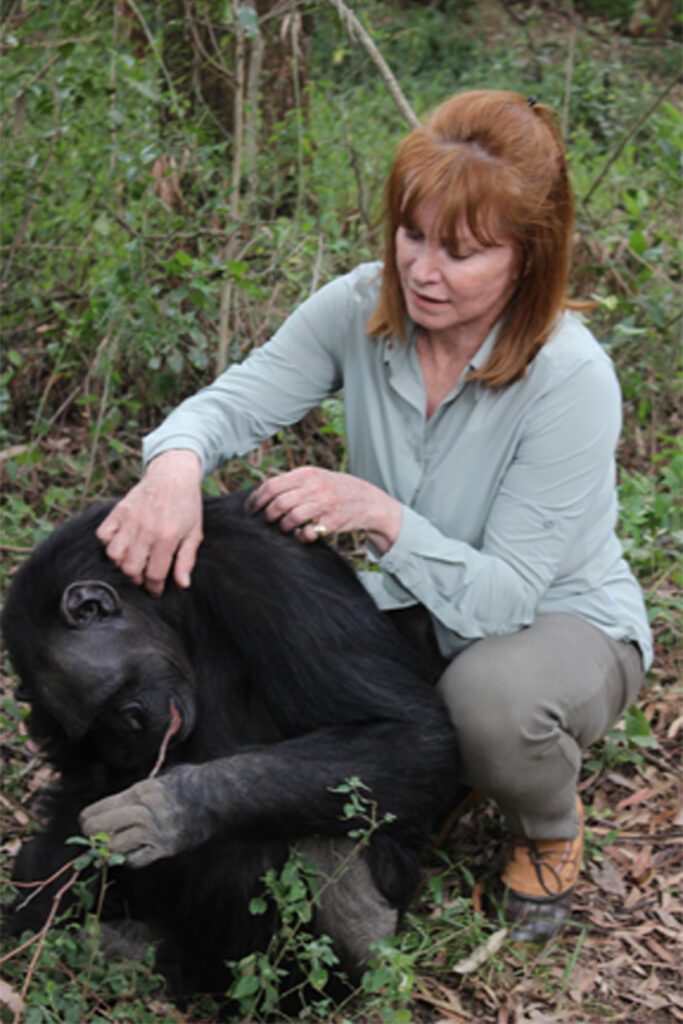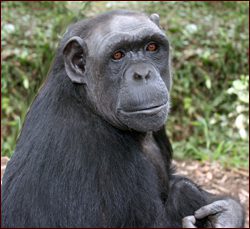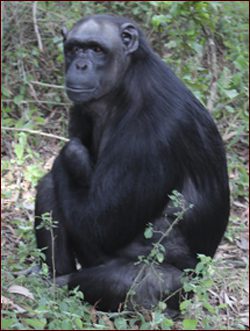
CHOCOLAT

UPDATE APRIL 2024
Since we last reported on Chocolat Monkey World in the UK, a world class home for rescued and rehabilitated primates, under the direction of Alison Cronin OBE, have offered sanctuary for Chocolat. Alison has known Graziella and Chocolat for years and is sensitive to the special needs involved. There is a wonderful and well qualified group of us working to make the journey of Chocolat to the UK possible. But we need funds to help make this a reality.
Please can you find your way to help us with this well deserving cause.
Stefanie Powers
President
To contribute to The Chocolat Fund please use the below PayPal button:
For the History of Chocolat's Story, please read below:
It must have been in 2007, while attending the pre-Christmas country fair in Nanyuki, that I met a lovely Belgium woman, Graziella Cotman, who was selling the most delicious handmade chocolates I've ever tasted.
Graziella was grateful to speak in French with me as it was the language she felt most comfortable in, and soon she invited me to visit her at her cottage outside of town where she said I could meet "Chocolat" ... I wasn't quite sure I had understood her correctly but she repeated her invitation and so, having tasted my fair share of chocolate but never having formally met chocolate, I accepted her invitation. When her door opened, I was surprised but delighted to meet Graziella's adorable rescued chimpanzee whose name is Chocolat (using the French pronunciation).
In the early 19th century, when the African continent was being partitioned into colonies by the European powers, King Leopold II took possession of one of the largest chunks of private property in the world and called it The Belgian Congo.
The Congo was a vast inhospitable jungle of exotic riches that attracted then as now not only soldiers of fortune, but all manner of exploitation. The Congo became independent in the 1960's along with most of the continent of Africa, but it has never entirely escaped from being a battlefield for those individuals who seek to enrich themselves through the pirating of gold, minerals, wildlife and human trafficking. Principle prey, among the most endangered species of wildlife are our closest relatives, the great apes. Adult chimpanzees are widely sought after as bush meat for human consumption, whose babies are then sold to the pet trade. Needless to say, eating a chimpanzee is akin to human cannibalism, considering that our DNA is a mere 95-98 percent the same.
In 1978, Graziella Cotman was living with her family in Kinshasa, The Congo. As a result of what was the beginning of a civil war, Graziella gave refuge to a Belgium couple who owned a baby chimpanzee. When the Belgium couple returned to Europe the young chimpanzee called Noelle remained living in the garden of Graziella's house. When Noelle was five years old, Grazielle took her to live with other chimpanzees in a national park called La Nsele. In 1981 Grazielle met with Dr. Jane Goodall in Kinshasa. The country was in turmoil and Jane requested Graziella's help in saving some young and moveable chimpanzees to Brazzaville where they would be safe. Sadly some of the larger chimps had to remain, including Noelle, because they could not be moved without being anesthetized. It was then that Graziella began her work at a new sanctuary called the Tchimpounga and was hired by the Jane Goodall Institute to manage it.
In July of 2001, a tiny baby chimp, probably only a month old, weighing between 1-2 kilograms arrived at the sanctuary. The baby was weak, traumatized and seriously injured when her mother had been shot by poachers while holding her baby to her chest to protect it. Poachers, men who hunt chimpanzees for meat to sell as a delicacy, have a diabolical practice of removing buckshot from their cartridges, filing the lead balls into sharp points, and reloading them into the shotgun shells in order to cause far more lethal and damaging effect. In this case, the poachers had killed not only the mother chimp, but buckshot had passed through them mother's body into the baby.
Through the efforts of the Jane Goodall Institute, a vet was sent from Paris to perform delicate surgery on this baby chimp, whose wounds on the back of her head had abscessed. All during her treatment, the baby showed such a willingness to be treated and such a will to live that she touched every one of the sanctuary staff.
But clearly Graziella became determined to do as much as she could to help the baby survive. The most accessible of the "bullets" were removed, but there appeared to be deeper wounds that needed more sophisticated equipment to locate, if in fact they were operable at all.
The absolute sweetness of this adorable baby plus the decidedly brown cast to her face led to her being called Chocolat. Chocolat's story attracted help from several exceptional people whose efforts resulted in flying Chocolat by private charter to the capital city of Gabon, Libreville to have a brain scan. The results showed that part of the brain had been destroyed and that there was shrapnel still lodged in her head, the nape of her neck and the bottom of her back, all inoperable. These "bullets" have caused permanent paralysis on the right side of her body and the loss of vision in her right eye. Still, Chocolat's resiliency, coupled with her amazing response to the affection and care she has received has given Chocolat a gentle kindness that is deeply touching.
For the first three years of her life, Graziella made sure that Chocolat's development was carefully monitored. Being disabled, Chocolat could not be released in the company of healthy chimps her age because they might pick on her, so her socialization took place with the newly-arrived orphans she comforted. There as always concern that Chocolat might injure herself unknowingly on her paralyzed side due to the sensitivity of her skin and her lack of feeling.
In the subsequent years, Graziella paid great attention to increasing the strength and stability of Chocolat's right side, even enlisting the help of pediatric doctors in Europe who donated specially made shoes for her handicapped foot which helped to re-align its conformation.
When the board of JGI retired Graziella after many years of service, she remained living in the Congo at her own expense in order to continue as a volunteer working with Chocolat.
Graziella began a tireless effort to gain permission to leave The Congo and move with her to Kenya where it was hoped she might join a sanctuary there. Finally the Congolese government placed Chocolat in the legal possession of Graziella and gave them permission to leave for Kenya.
She did not join the sanctuary in Kenya, although she socialized with many baby orphans, due to sanctuary not being able to accommodate Chocolat's needs. Graziella then rented a property with a large overgrown garden where Chocolat plays all day in the company of a human nanny, and has her own little cottage where she sleeps at night. She is also habituated to human visitors from time to time.
Graziella's constant concern is for Chocolat's future, a chimpanzee can live for 60 years and, in the meantime, Graziella's finances are limited as she lives on her retirement pension.
It is a long and complicated process to get permission to transport internationally a chimpanzee, even one with special needs, as we search for an ideal home for Chocolat, she still requires food, care and maintenance.
To contribute to The Chocolat Fund please use the below PayPal button:


